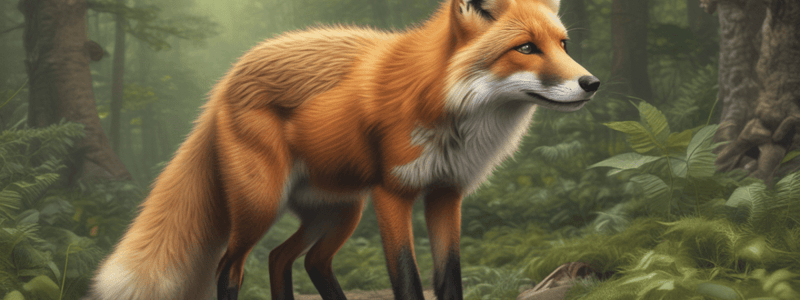Podcast
Questions and Answers
What is the purpose of the arctic fox's change in color?
What is the purpose of the arctic fox's change in color?
- To scare away predators
- To attract a mate
- To blend in with the surroundings (correct)
- To communicate with other arctic foxes
What is unique about the fur of arctic foxes?
What is unique about the fur of arctic foxes?
- It is the warmest of any mammal (correct)
- It is the thickest of any mammal
- It is the longest of any mammal
- It is the lightest of any mammal
Why do foxes in deserts have big ears?
Why do foxes in deserts have big ears?
- To help them see in the dark
- To help them run faster
- To help their bodies get rid of extra heat (correct)
- To hear predators from a distance
What is the purpose of a fox's den?
What is the purpose of a fox's den?
What is unique about some arctic-fox dens?
What is unique about some arctic-fox dens?
How fast can a red fox run?
How fast can a red fox run?
What is the purpose of a fox's whiskers?
What is the purpose of a fox's whiskers?
What is special about a fox's fur?
What is special about a fox's fur?
Why do foxes shed their winter coats in the spring?
Why do foxes shed their winter coats in the spring?
What animal group do foxes, dogs, wolves, and coyotes belong to?
What animal group do foxes, dogs, wolves, and coyotes belong to?
Flashcards are hidden until you start studying
Study Notes
Fox Characteristics
- Foxes have sensitive whiskers on their faces that help them find out about their surroundings and feel tiny movements of animals in the grass.
- They have triangle-shaped ears, pointed noses, and bushy tails, resembling small dogs.
- Foxes are warm-bodied mammals that have fur-covered bodies and feed their babies milk, belonging to the same animal group as dogs, wolves, and coyotes.
- They are known for their beautiful, thick coats, which help them hide through camouflage.
Fox Adaptations
- Foxes grow heavier coats to keep them warm in the winter and shed the extra fur in the spring for a lighter summer coat.
- Arctic foxes change color completely with the seasons, turning white in winter and gray or brown in the summer.
- Desert foxes have short fur and big ears to help their bodies get rid of extra heat.
- Arctic foxes have small ears, short legs, and the warmest fur of any mammal, able to stay warm even in extreme cold.
Types of Foxes
- There are over 20 different kinds, or species of foxes, found in almost every part of the world except Antarctica.
- Red foxes are the most common and best known, living throughout most of North America and other parts of the world.
- Gray foxes have shorter legs and gray fur, found throughout the US and Mexico.
- Arctic foxes live only in the far north, while swift foxes and kit foxes are smaller types from grasslands and deserts of western North America.
- Fennec foxes of Africa's Sahara Desert are one of the smallest kinds, weighing only 2 to 3 pounds.
Fox Dens
- All foxes make use of dens, which are safe places to rest, raise babies, or escape from enemies.
- Dens keep foxes warm and dry in bad weather or shaded and cool in hot weather.
- Foxes make their dens in hollow logs, under big rocks, and under fallen trees, sometimes even digging tunnels into the ground.
- Arctic fox dens can be huge, with dozens of entrances, and can be up to 300 years old.
- Gray fox dens are sometimes in hollow trees, and they have sharp, hooked claws that allow them to climb trees.
Studying That Suits You
Use AI to generate personalized quizzes and flashcards to suit your learning preferences.




